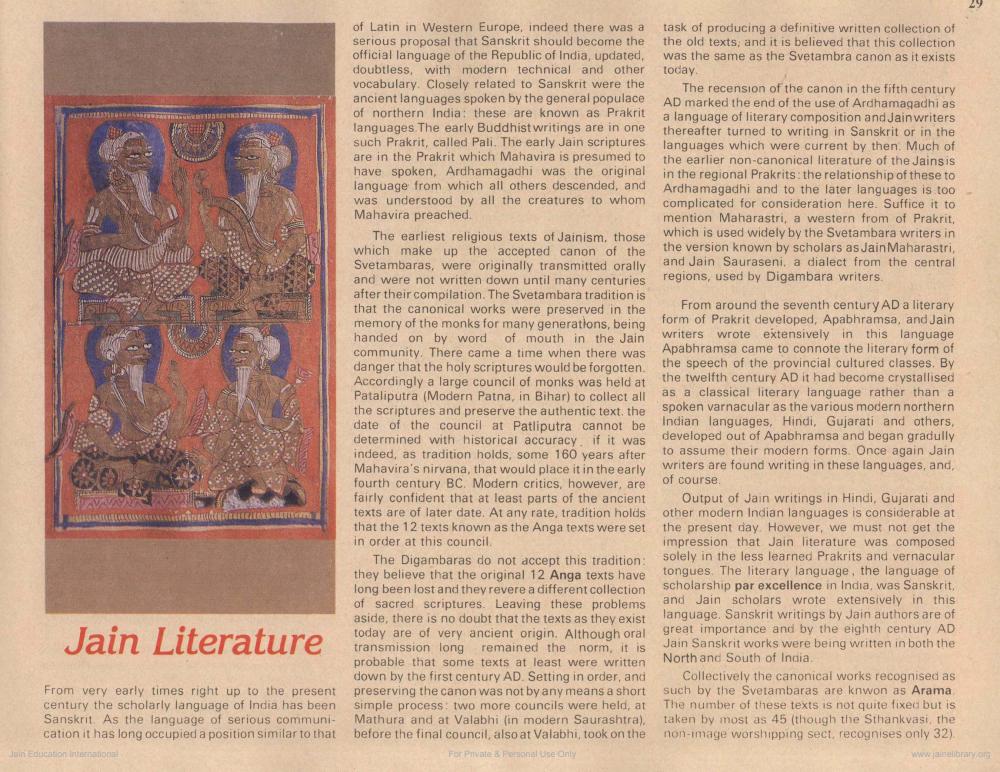________________
29
STAND
of Latin in Western Europe, indeed there was a task of producing a definitive written collection of serious proposal that Sanskrit should become the the old texts, and it is believed that this collection official language of the Republic of India, updated was the same as the Svetambra canon as it exists doubtless, with modern technical and other today vocabulary. Closely related to Sanskrit were the ancient languages spoken by the general populace
The recension of the canon in the fifth century
AD marked the end of the use of Ardhamagadhi as of northern India: these are known as Prakrit a language of literary composition and Jain writers languages. The early Buddhist writings are in one thereafter turned to writing in Sanskrit or in the such Prakrit, called Pall. The early Jain scriptures languages which were current by then. Much of are in the Prakrit which Mahavira is presumed to the earlier non.canonical literature of the Jainsis have spoken, Ardhamagadhi was the original in the regional Prakrits: the relationship of these to language from which all others descended, and Ardhamagadhi and to the later languages is too was understood by all the creatures to whom complicated for consideration here. Suffice it to Mahavira preached
mention Maharastri, a western from of Prakrit, The earliest religious texts of Jainism, those
which is used widely by the Svetambara writers in which make up the accepted canon of the
of the the version known by scholars as Jain Maharastri, Svetambaras, were originally transmitted orally and Jain Sauraseni, a dialect from the central and were not written down until many centuries regions, used by Digambara writers. after their compilation. The Svetambara tradition is that the canonical works were preserved in the
From around the seventh century AD a literary memory of the monks for many generations, being
form of Prakrit developed, Apabhramsa, and Jain handed on by word of mouth in the Jain
writers wrote extensively in this language community. There came a time when there was
Apabhramsa came to connote the literary form of danger that the holy scriptures would be forgotten.
the speech of the provincial cultured classes. By Accordingly a large council of monks was held at the twelfth century AD it had become crystallised Pataliputra (Modern Patna, in Bihar) to collect all as a classical literary language rather than a the scriptures and preserve the authentic text, the spoken varnacular as the various modern northern date of the council at Patliputra cannot be Indian languages,Hindi, Gujarati and others, determined with historical accuracy if it was developed out of Apabhramsa and began gradully indeed, as tradition holds, some 160 vears after to assume their modern forms. Once again Jain Mahavira's nirvana, that would place it in the early writers are found writing in these languages, and, fourth century BC Modern critics, however, are of course. fairly confident that at least parts of the ancient Output of Jain writings in Hindi, Gujarati and texts are of later date. At any rate, tradition holds other modern Indian languages is considerable at that the 12 texts known as the Anga texts were set the present day. However, we must not get the in order at this council.
impression that Jain literature was composed The Digambaras do not accept this tradition: solely in the less learned Prakrits and vernacular they believe that the original 12 Anga texts have
texts have tongues. The literary language, the language of long been lost and they revere a different collection scholarship par excellence in India, was Sanskrit, of sacred scriptures. Leaving these problems and Jain scholars wrote extensively in this aside, there is no doubt that the texts as they exist language. Sanskrit writings by Jain authors are of today are of very ancient origin. Although oral great importance and by the eighth century AD transmission long remained the norm it is Jain Sanskrit works were being written in both the probable that some texts at least were written North and South of India down by the first century AD. Setting in order, and Collectively the canonical works recognised as preserving the canon was not by any means a short such by the Svetambaras are knwon as Arama simple process two more councils were held at the number of these texts is not quite fixed but is Mathura and at Valabhi (in modern Saurashtra), taken by most as 45 (though the Sthankvasi, the before the final council, also at Valabhi, took on the non-image worshipping sect. recognises only 32)
For Pr o use only
M
EGTART
Jain Literature
From very early times right up to the present century the scholarly language of India has been Sanskrit. As the language of serious communi-
cation it has long occupied a position similar to that Junction n ation




